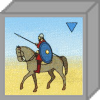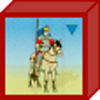Historical Background
After driving Gnaeus Pompey from Italy, Julius Caesar moved against Pompey’s forces in Spain. Caesar had sent Gaius Fabius ahead to secure the passes over the Pyrenees and at the Sicoris River. Fabius succeeded, and his opponent, Pompey’s lieutenant Afranius, was forced to retire southward. Caesar followed Afranius and camped about a half mile from his enemy and the town of Ilerda. Between the enemy camp and town there was a hillock, which appeared to Caesar as the best strategic position in the area. However, Afranius saw what Caesar intended and managed to gain the hill first, leaving Caesar’s army in an awkward position. To relieve this situation, Caesar led his legions forward, but after some initial success they pressed their attack too far. The enemy effectively showered them with missiles from higher ground. Caesar’s veterans were in a difficult position. They were taking unnecessary losses where they stood, but would take as many losses withdrawing. Caesar ordered forward his cavalry, which relived the pressure and gave his legions the opportunity to withdraw. The battle ended in a stalemate as both sides pulled back. A three-month campaign followed, in which Caesar masterfully outmaneuvered Afranius, forcing the Pompeian army of seven veteran legions in Spain to surrender without fighting another major battle.
The stage is set. The battle lines are drawn and you are in command. The rest is history.

 |
 |
 |
 |
 |
 |
||||||||||||||
| 2 | 2 | 5 | 4 | 2 | 3 | ||||||||||||||
 |
 |
 |
 |
 |
 |
||||||||||||||
| 1 | 2 | 4 | 6 | 2 | 3 |
War Council
Pompeian Army
• Leader: Afranius
• 5 Command Cards ![]()
![]()
![]()
![]()
![]()
• Move First ![]()
Caesarian Army
• Leader: Caesar
• 6 Command Cards ![]()
![]()
![]()
![]()
![]()
![]()
Victory
7 Banners
Special Rules
• The city walls of Ilerda (rampart hexes) are scalable.
• The river is impassable.
• Julian Legions rule is in effect for both armies.
• Julius Caesar Rule is in effect.
• When a unit occupies an enemy camp hex at the start of the player’s turn, remove the camp terrain tile hex. When both enemy camp hexes are removed, collect one Victory Banner.
• When more of Caesar units occupy the hillock, in the center section, than his opponent, collect one Victory Banner.
